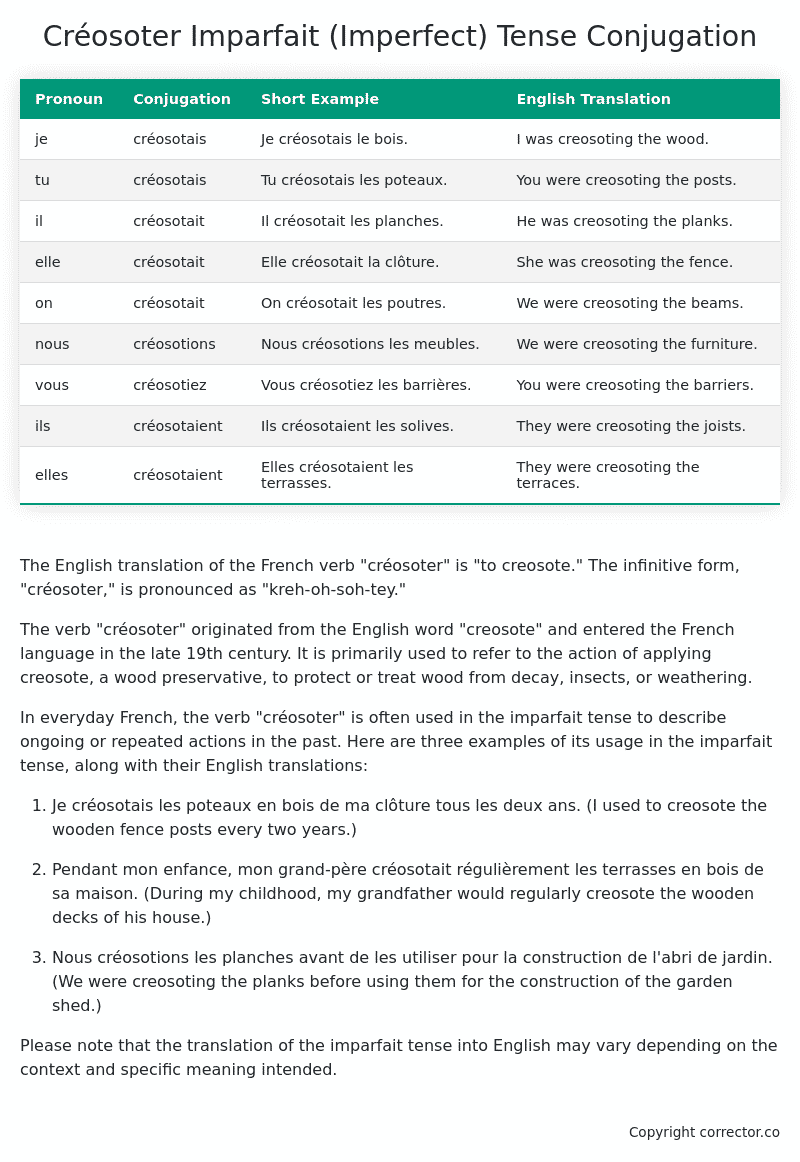Imparfait (Imperfect) Tense Conjugation of the French Verb créosoter
Introduction to the verb créosoter
The English translation of the French verb “créosoter” is “to creosote.” The infinitive form, “créosoter,” is pronounced as “kreh-oh-soh-tey.”
The verb “créosoter” originated from the English word “creosote” and entered the French language in the late 19th century. It is primarily used to refer to the action of applying creosote, a wood preservative, to protect or treat wood from decay, insects, or weathering.
In everyday French, the verb “créosoter” is often used in the imparfait tense to describe ongoing or repeated actions in the past. Here are three examples of its usage in the imparfait tense, along with their English translations:
-
Je créosotais les poteaux en bois de ma clôture tous les deux ans.
(I used to creosote the wooden fence posts every two years.) -
Pendant mon enfance, mon grand-père créosotait régulièrement les terrasses en bois de sa maison.
(During my childhood, my grandfather would regularly creosote the wooden decks of his house.) -
Nous créosotions les planches avant de les utiliser pour la construction de l’abri de jardin.
(We were creosoting the planks before using them for the construction of the garden shed.)
Please note that the translation of the imparfait tense into English may vary depending on the context and specific meaning intended.
Table of the Imparfait (Imperfect) Tense Conjugation of créosoter
| Pronoun | Conjugation | Short Example | English Translation |
|---|---|---|---|
| je | créosotais | Je créosotais le bois. | I was creosoting the wood. |
| tu | créosotais | Tu créosotais les poteaux. | You were creosoting the posts. |
| il | créosotait | Il créosotait les planches. | He was creosoting the planks. |
| elle | créosotait | Elle créosotait la clôture. | She was creosoting the fence. |
| on | créosotait | On créosotait les poutres. | We were creosoting the beams. |
| nous | créosotions | Nous créosotions les meubles. | We were creosoting the furniture. |
| vous | créosotiez | Vous créosotiez les barrières. | You were creosoting the barriers. |
| ils | créosotaient | Ils créosotaient les solives. | They were creosoting the joists. |
| elles | créosotaient | Elles créosotaient les terrasses. | They were creosoting the terraces. |
Other Conjugations for Créosoter.
Le Present (Present Tense) Conjugation of the French Verb créosoter
Imparfait (Imperfect) Tense Conjugation of the French Verb créosoter (You’re reading it right now!)
Passé Simple (Simple Past) Tense Conjugation of the French Verb créosoter
Passé Composé (Present Perfect) Tense Conjugation of the French Verb créosoter
Futur Simple (Simple Future) Tense Conjugation of the French Verb créosoter
Futur Proche (Near Future) Tense Conjugation of the French Verb créosoter
Plus-que-parfait (Pluperfect) Tense Conjugation of the French Verb créosoter
Passé Antérieur (Past Anterior) Tense Conjugation of the French Verb créosoter
Futur Antérieur (Future Anterior) Tense Conjugation of the French Verb créosoter
Subjonctif Présent (Subjunctive Present) Tense Conjugation of the French Verb créosoter
Subjonctif Passé (Subjunctive Past) Tense Conjugation of the French Verb créosoter
Subjonctif Imparfait (Subjunctive Imperfect) Tense Conjugation of the French Verb créosoter
Subjonctif Plus-que-parfait (Subjunctive Pluperfect) Tense Conjugation of the French Verb créosoter
Conditionnel Présent (Conditional Present) Tense Conjugation of the French Verb créosoter
Conditionnel Passé (Conditional Past) Tense Conjugation of the French Verb créosoter
Conditionnel Passé II (Conditional Past II) Tense Conjugation of the French Verb créosoter
L’impératif Présent (Imperative Present) Tense Conjugation of the French Verb créosoter
L’impératif Passé (Imperative Past) Tense Conjugation of the French Verb créosoter
L’infinitif Présent (Infinitive Present) Tense Conjugation of the French Verb créosoter
L’infinitif Passé (Infinitive Past) Tense Conjugation of the French Verb créosoter
Le Participe Présent (Present Participle) Tense Conjugation of the French Verb créosoter
Le Participe Passé (Past Participle) Tense Conjugation of the French Verb créosoter
Struggling with French verbs or the language in general? Why not use our free French Grammar Checker – no registration required!
Get a FREE Download Study Sheet of this Conjugation 🔥
Simply right click the image below, click “save image” and get your free reference for the créosoter imparfait tense conjugation!

Créosoter – About the French Imparfait Tense
NOTE: To take a deep dive into all the French tenses then see our article on Mastering French Tense Conjugation.
Formation of the Imparfait Tense
For regular -er verbs:
For regular -ir verbs
For regular -re verbs
Common Everyday Usage Patterns
Description of Past Habits
Background Information
Mental and Emotional States
It’s employed to express emotions, thoughts, or physical sensations in the past. For example: “J’étais content quand il est arrivé.” (I was happy when he arrived.)
Ongoing Actions
Points to Note About the Imparfait Tense
Passé Composé vs. Imparfait
Conditional
Si Clauses
Narration
I hope you enjoyed this article on the verb créosoter. Still in a learning mood? Check out another TOTALLY random French verb imparfait conjugation!


